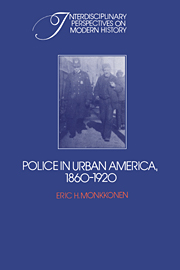2 - Arrest trends, 1860 – 1920
Published online by Cambridge University Press: 23 October 2009
Summary
To my own mind the entire subject [defective, dependent, and delinquent classes] is one. The causes at work in our modern society … affect the growth of all of them.
Frederick H. Wines, Report on Defective, Dependent, and Delinquent Classes … (1888)Previous studies of arrest and crime trends
By establishing a new national data series for arrest rates and police strength, this chapter answers some of the questions and clarifies some of the issues, definitions, and problems involved in the study of urban crime and police from before the Civil War until after World War I. For in spite of increasing scholarly attention to crime, violence, and the police, several simple yet critically important historical questions remain unanswered. Significant social change occurred between the Civil War and World War I. Wars, depressions, vast population movements, and an economic transformation all affected the behavior of persons who produced crime and disorder – the “dangerous class.” The same broad social and economic forces also affected the urban bureaucracy created to control the “dangerous class,” for the uniformed police grew increasingly strong, specialized and bureaucratized. There are broad questions to ask about crime during this period. As the United States changed from a booming agricultural nation to an industrialized world military power, did crime increase or decrease? Did its growing social and economic complexity demand more or less public order?
- Type
- Chapter
- Information
- Police in Urban America, 1860–1920 , pp. 65 - 85Publisher: Cambridge University PressPrint publication year: 1981

